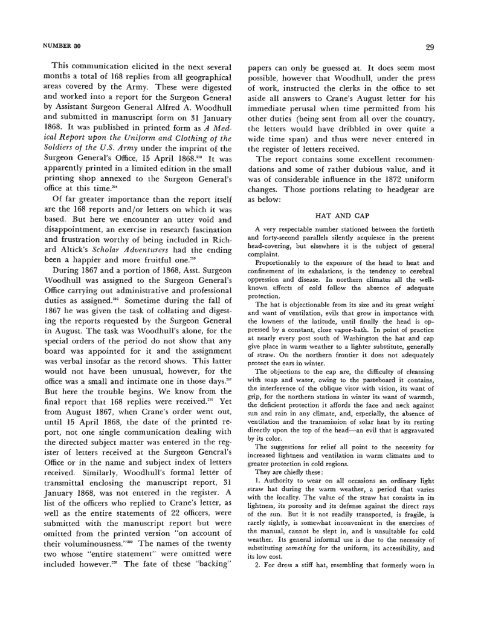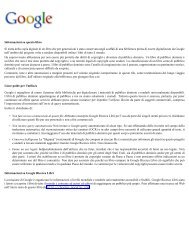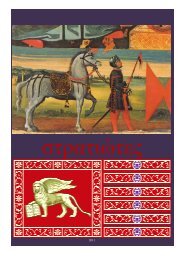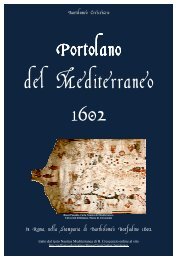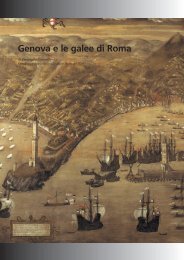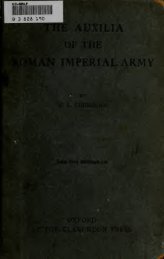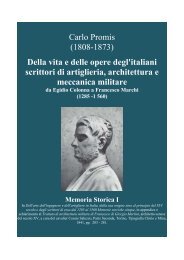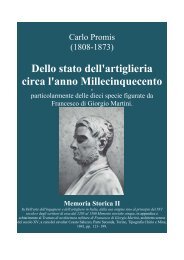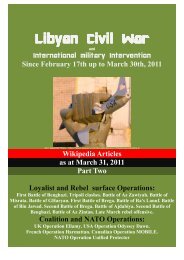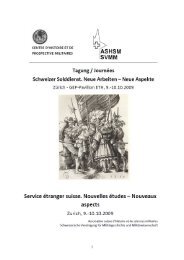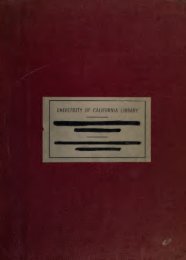28 SMITHSONIAN STUDIES IN HISTORY AND TECHNOLOGYbut withheld the issue of caps to any but the lightbatteries since they would have to be purchased,adding to his endorsement that "the new regulationsmay prescribe a new uniform."""'The end of the light artillery cap in the <strong>Army</strong>came in the summer of 1872 with the authorizationof a new uniform for the whole <strong>Army</strong> and adirective by the Secretary of War to sell at auctionall such caps and insignia (but with no mentionof the red hair plumes) at public auction.'"'THE 1872 REGULATION HEADGEARWar Department General Orders Nos. 76 and 92,issued 29 July and 26 October 1872, respectively,prescribed an almost entirely new uniform for theofficers and enlisted men of the <strong>Army</strong>. As to headgear,for full dress, for general officers, officers ofthe general staff, and staff corps, a chapeau; forlight artillery, cavalry, and enlisted men of theSignal Corps a black felt helmet with appropriatetrimmings, distinctly Prussian in style; for foottroops a cap, again appropriately trimmed, ofFrench design; for undress, a forage cap, "chasseurpattern," very reminiscent of the "McClellan" type,which had been so popular with officers during andafter the Civil War; and for fatigue and campaignwear, a campaign hat of a distinctly different patternfrom that adopted for the whole <strong>Army</strong> in 1858.Despite some agitation within the <strong>Army</strong>, particularlyamong the officers, during the middle andlate 1860s for a change, such was just not economicallyfeasible.'"" Of the more than 1,000,000 volunteerson the rolls in May 1865, better than 800,000had been demobilized by November of the sameyear. By September 1866 the strength of theRegular Establishment had dropped to less than39,000.'°' Thus, the <strong>Army</strong> was left with huge stocksof uniforms, arms, and equipment which couldonly be disposed of on the open market at a tremendousloss, which would have brought screams ofanguish from economy-minded Congress, and thushad to be used.'"' In 1870 Meigs in his annualreport wrote:No appropriation for the clothing and camp equipage ofthe <strong>Army</strong> has been made since the war [and none had beenasked for]. The large appropriation made early in 1865 andthe proceeds of sales of surplus and damaged clothing havesufficed for . . . the purchase or manufacture of such articlesas were not in store and have been needed for the past fiveyears.Meigs went on to say, however, that the Act of12 July 1870 forbidding the use of balances of appropriations,except for the payment of obligationsincurred during the year for which the appropriationswere made, had left the <strong>Army</strong> with no fundsfor the purchase of such clothing and equipage notin store during the current fiscal year.'""In closing his report, Meigs mirrored the conservatismof some of the older officers regarding auniform change:Some officers desire to see a change in the <strong>Army</strong> uniform.I think that, while so large a stock of clothing still remainson hand, such a change is inadvisable. It would involve anunnecessary expenditure of public money. The uniform inwhich the people of the country fought the battles and madethe campaigns of the war is endeared to them by the recollectionof many a hard-fought field and many a bivouac. Itis simple, inexpensive, serviceable, and military. Those wholead lives, like that of the soldier, in the forest or in thewilderness, seek to purchase the surplus articles of <strong>Army</strong>clothing as the most durable and serviceable they can obtain.The armies of Europe tend to the use of materials like ours.The dark blue coat and blouse, the light blue trousers, forma uniform unsurpassed in any service for actual duty in thefield.""But stocks of many items were running low or hadbeen exhausted and long storage had resulted inconsiderable deterioration, all of which necessitateda request for a deficiency appropriation in the fiscalyear 1871."' The time for a uniform changewas approaching.The'^Woodhull Report"On 3 August 1867, C.H. Crane, the AssistantSurgeon General of the <strong>Army</strong>, wrote as follows tothe Medical Directors and Chief Medical Officersof the <strong>Army</strong>:You are respectfully requested to call upon med'cal officersof experience, serving under your command, for theiropinions regarding the hygienic fitness (for the localitieswhere they are now on duty) of the present uniform andallowance of clothing for enlisted men, and to invite suggestionsfor its modification.You will please collect these reports, without delay, andtransmit them, with your remarks, to this office.By order of the Surgeon General:"'
NUMBER 30 29This communication elicited in the next severalmonths a total of 168 replies from all geographicalareas covered by the <strong>Army</strong>. These were digestedand worked into a report for the Surgeon Generalby Assistant Surgeon General Alfred A. Woodhulland submitted in manuscript form on 31 January1868. It was published in printed form as A MedicalReport upon the Uniform and Clothing of theSoldiers of the U.S. <strong>Army</strong> under the imprint of theSurgeon General's Office, 15 April 1868."' It wasapparently printed in a limited edition in the smallprinting shop annexed to the Surgeon General'soffice at this time.'"Of far greater importance than the report itselfare the 168 reports and/or letters on which it wasbased. But here we encounter an utter void anddisappointment, an exercise in research fascinationand frustration worthy of being included in RichardAltick's Scholar Adventurers had the endingbeen a happier and more fruitful one.""During 1867 and a portion of 1868, Asst. SurgeonWoodhull was assigned to the Surgeon General'sOffice carrying out administrative and professionalduties as assigned."" Sometime during the fall of1867 he was given the task of collating and digestingthe reports requested by the Surgeon Generalin August. The task was Woodhull's alone, for thespecial orders of the period do not show that anyboard was appointed for it and the assignmentwas verbal insofar as the record shows. This latterwould not have been unusual, however, for theoffice was a small and intimate one in those days."'But here the trouble begins. We know from thefinal report that 168 replies were received."' Yetfrom August 1867, when Crane's order went out,until 15 April 1868, the date of the printed report,not one single communication dealing withthe directed subject matter was entered in the registerof letters received at the Surgeon General'sOffice or in the name and subject index of lettersreceived. Similarly, Woodhull's formal letter oftransmittal enclosing the manuscript report, 31January 1868, was not entered in the register. Alist of the officers who replied to Crane's letter, aswell as the entire statements of 22 officers, weresubmitted with the manuscript report but wereomitted from the printed version "on account oftheir voluminousness.""" The names of the twentytwo whose "entire statement" were omitted wereincluded however."" The fate of these "backing"papers can only be guessed at. It does seem mostpossible, however that Woodhull, under the pressof work, instructed the clerks in the office to setaside all answers to Crane's August letter for hisimmediate perusal when time permitted from hisother duties (being sent from all over the country,the letters would have dribbled in over quite awide time span) and thus were never entered inthe register of letters received.The report contains some excellent recommendationsand some of rather dubious value, and itwas of considerable influence in the 1872 uniformchanges. Those portions relating to headgear areas below:HAT AND CAPA very respectable number stationed between the fortiethand forty-second parallels silently acquiesce in the presenthead-covering, but elsewhere it is the subject of generalcomplaint.Proportionably to the exposure of the head to heat andconfinement of its exhalations, is the tendency to cerebraloppression and disease. In northern climates all the wellknowneffects of cold follow the absence of adequateprotection.The hat is objectionable from its size and its great weightand want of ventilation, evils that grow in importance withthe lowness of the latitude, until finally the head is oppressedby a constant, close vapor-bath. In point of practiceat nearly every post south of Washington the hat and capgive place in warm weather to a lighter substitute, generallyof straw. On the northern frontier it does not adequatelyprotect the ears in winter.The objections to the cap are, the difficulty of cleansingwith soap and water, owing to the pasteboard it contains,the interference of the oblique visor with vision, its want ofgrip, for the northern stations in winter its want of warmth,the deficient protection it affords the face and neck againstsun and rain in any climate, and, especially, the absence ofventilation and the transmission of solar heat by its restingdirectly upon the top of the head—an evil that is aggravatedby its color.The suggestions for relief all point to the necessity forincreased lightness and ventilation in warm climates and togreater protection in cold regions.They are chiefly these:1. Authority to wear on all occasions an ordinary lightstraw hat during the warm weather, a period that varieswith the locality. The value of the straw hat consists in itslightness, its porosity and its defense against the direct raysof the sun. But it is not readily transported, is fragile, israrely sightly, is somewhat inconvenient in the exercises ofthe manual, cannot be slept in, and is unsuitable for coldweather. Its general informal use is due to the necessity ofsubstituting something for the uniform, its accessibility, andits low cost.2. For dress a stiff hat, resembling that formerly worn in
- Page 1: • ^ - :lP-'L^ry\'^ ^iT
- Page 4 and 5: ABSTRACTHowell, Edgar M. United Sta
- Page 7 and 8: ContentsPagePrefaceiiiThe 1855 Cava
- Page 9 and 10: United States Army Headgear 1855-19
- Page 11 and 12: NUMBER 30report, stated: "The hat p
- Page 13 and 14: NUMBER 30acorns %g inches long and
- Page 15 and 16: NUMBER 30the pattern." The rate of
- Page 17 and 18: NUMBER 30FIGURE 3.—1858 Army hat.
- Page 19 and 20: NUMBER 3011model, number 60 in the
- Page 21 and 22: NUMBER 30 13"the desired modificati
- Page 23 and 24: NUMBER 30 15the sun in the top. The
- Page 25 and 26: NUMBER 30 17FIGURE 8.—1858 forage
- Page 27 and 28: NUMBER 30 19Hardtack and Coffee, ca
- Page 29 and 30: NUMBER 3021FIGURE 11.—a, Brigadie
- Page 31 and 32: NUMBER 30 23short "shell" jacket "f
- Page 33 and 34: NUMBER 30 26broad, securely soldere
- Page 35: NUMBER 30 27worn in the picture wer
- Page 39 and 40: NUMBER 30 31FIGURE 17.—"The [Scot
- Page 41 and 42: NUMBER 30 33time for issue in the c
- Page 43 and 44: NUMBER 30 35be at too great a dista
- Page 45 and 46: NUMBER 3037half (5/2) part of washb
- Page 47 and 48: NUMBER 30 39trimmings for all enlis
- Page 49 and 50: NUMBER 30 41ing the upper space for
- Page 51 and 52: NUMBER 30rear one to a correspondin
- Page 53 and 54: NUMBER 30 46FIGURE 29.—1872 enlis
- Page 55 and 56: NUMBER 3047FIGURE 32.—^The Bent &
- Page 57 and 58: NUMBER 3049of strong split-leather
- Page 59 and 60: NUMBER 30 51''""MttfenFIGURE 35.—
- Page 61 and 62: NUMBER 30 53(which he thought might
- Page 63 and 64: NUMBER 30 55FIGURE 38.—Captain Be
- Page 65 and 66: NUMBER 30 57campaign hat for the Ar
- Page 67 and 68: NUMBER 30 59salvage something from
- Page 69 and 70: NUMBER 30 61hat. In June 1899 the P
- Page 71 and 72: NUMBER 3063the left side, pass diag
- Page 73 and 74: NUMBER 30 65.LJU^.."*^..FIGURE 44.
- Page 75 and 76: NUMBER 30 67to be sent to Washingto
- Page 77 and 78: NUMBER 30 69with brass sliding-buck
- Page 79 and 80: NUMBER 30 71FIGURE 48.—Officers'
- Page 81 and 82: NUMBER 3073The adoption of the whit
- Page 83 and 84: NUMBER 3075i >•^\Wiii I ifiiiniim
- Page 85 and 86: NUMBER 30this last model made no pr
- Page 87 and 88:
NUMBER 30 79WAR DEPARTMENT,QUARTERM
- Page 89 and 90:
NUMBER 3081FIGURE 58.—1864 chapea
- Page 91 and 92:
NUMBER 30geon 1880 and Surgeon Gene
- Page 93 and 94:
NUMBER 3085FIGURE 63.—1895 forage
- Page 95 and 96:
NUMBER 30 87of not less than 9.24 g
- Page 97 and 98:
AppendixMAKERS OF HEADGEARThe chron
- Page 99 and 100:
List of AbbreviationsAAGAAQMAGAGOAQ
- Page 101 and 102:
NUMBER 3093all OQMG, LS, Clothing,
- Page 103 and 104:
NUMBER 30 95"Jesup to Thomas, 8 Dec
- Page 105 and 106:
NUMBER 3097OQMG, Reg. LR, Clothing,
- Page 107 and 108:
NUMBER 30 99October of 1870. See Me
- Page 109 and 110:
NUMBER 30 101'"* See above, pp. 35-
- Page 111 and 112:
NUMBER 30 103Monroe, Va., in 1878.
- Page 113 and 114:
NUMBER 30 105""Endorsement, 24 May
- Page 115 and 116:
ReferencesThe bulk of the source ma
- Page 117:
M MBIiR 30 10910, No. 355-10, 19 Se


